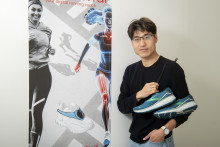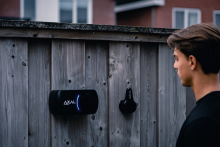Nothing is quite as unpleasant as sustaining an injury while playing sports. The same occurred to Huawei. ‘Rather undesirable, as the prescription often comes down to rest and as a sporty person you don't really feel like that.’ An immediate colleague also suffered an injury one week before a marathon. ‘Incredibly unfortunate. Everything had been booked, arranged and, above all, trained. And then you can't go.’

It got Wang thinking. ‘I have been working on human movement science for almost ten years. We have good understanding of muscles and joints, for example the muscle strength, joint loads, and how they build up fatigues and eventually reach injuries. But we don't put that knowledge to use for daily interactions. After my own injury and that of my colleague, everything came together.’
Predicting risk of injury
It marked the birth of wearM.AI, arguments sporty shoes with smart sensors. These augmented shoes provide information about body's movements, muscle usages, and fatigue levels while people are doing sports outdoor. ‘We link the sensor outputs to a digital musculoskeletal model and create in-depth digital twins. Through algorithms and calculations, we know when a muscle is overloaded and can predict possible risk of injury.’
Collecting data
Our current narrow focus is on the running sport, in which injuries are very big problems. About half of the worldwide running population (600 million) get injured every year! To launch the application, the company is currently conducting research with a large number of runners. ‘We are moving from the lab to outside and want to collect as much data as possible from runners outdoors. They don't mind to add extra weights on the shoes during training sessions. The smart sensor straps easily on top of the running shoes and weighs 30 to 40 grams. In races, they prefer not to wear the running shoes. And that's OK for our target count.’
Based on a large database, wearM.AI can predict injuries with our advanced machine learning algorithms. ‘And give advice on taking rest or changing running techniques, for example.’ This information is all available to the runners via a mobile app or their Garmin watches.

Not only sporty people can benefit from these technical applications, elderly people and rehabilitating users are also a suitable target audience. ‘Elderly people can receive advice on which activities and movements are best to incorporate throughout the day to keep healthy but not overusing the declined joints and muscles functions. And for rehabilitation, both patient and physiotherapist gain insight into how the body recovery from injuries. This benefits exercise prescription and recovery.’
Launch
Besides talking with runners, Wang is in consultation with running shops and the running physiotherapists. ‘They have unique angles in looking the running sports and the existing obstacles. We also have plenty of meetings with investors. And that is necessary, because I will start working full-time for WEARM.AI from next year onwards. In two years’ time, we expect to launch the smart device with mobile app as a product on the market.’
Booming business
This article is part of the U-Today LinkedIn series Booming Business.







